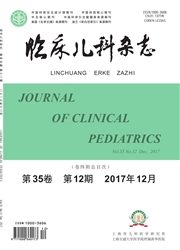

 中文摘要:
中文摘要:
目的探讨结节性硬化伴或不伴婴儿痉挛表型与基因型的相关性。方法选择临床诊断结节性硬化的15例患儿为研究对象,8例伴婴儿痉挛,7例不伴婴儿痉挛,分析其临床表现、结节性硬化基因突变特征。结果7例伴婴儿痉挛的结节性硬化患儿存在TSC2基因突变,发现5种新突变位点:c.4305-4306delAG,c_4255-4258delCAGT,c.4734-4735insGGCC,c.4245delG,c.1901-1902insAT;6例不伴婴儿痉挛的结节性硬化患儿也存在TSC2基因突变,包括2种新突变:c.246G〉A,c.3691-3694delCTGT;另有1例为TSC/基因突变。结论结节性硬化基因突变类型及位点与结节性硬化伴或不伴婴儿痉挛表型的关系不明确。
 英文摘要:
英文摘要:
Objectives To investigate the characteristics of the clinical phenotype and gene mutations in patients with tuberous sclerosis complex (TSC) with/without infantile spasms (IS). Methods Fifteen infants with TSC were en- rolled in the study, 8 were with IS and 7 without. Their clinical manifestations and mutations of TSC gene were analyzed. Results A total of 5 novel TSC2 mutations, c.4305 4306delAG, c.4255_4258delCAGT, c.4734_4735insGGCC, c.4245delG, c.1901_1902insAT, were identified in 7 TSC cases with IS. TSC2 mutations were also found in 6 TSC cases without IS, 2 of mutations (c.246G〉A, c.3691 3694delCTGT) were new. Besides, one TSC1 mutation was detected in a TSC infant without IS. Conclusions The correlations between genotype and phenotype in TSC with/without IS are not clear based on this study.
 同期刊论文项目
同期刊论文项目
 同项目期刊论文
同项目期刊论文
 A possible association of responsiveness to adrenocorticotropic hormone with specific GRIN1 haplotyp
A possible association of responsiveness to adrenocorticotropic hormone with specific GRIN1 haplotyp Genetic polymorphisms of MC2R gene associated with responsiveness to adrenocorticotropic hormone the
Genetic polymorphisms of MC2R gene associated with responsiveness to adrenocorticotropic hormone the ACTH receptor (MC2R) promoter variants associated with infantile spasms modulate MC2R expression and
ACTH receptor (MC2R) promoter variants associated with infantile spasms modulate MC2R expression and Analysis of single nucleotide polymorphisms in the melanocortin-4 receptor promoter in infantile spa
Analysis of single nucleotide polymorphisms in the melanocortin-4 receptor promoter in infantile spa 期刊信息
期刊信息
